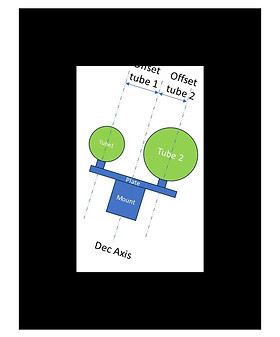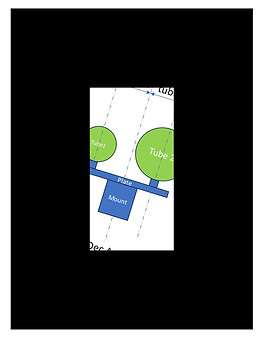Side By Side Setup
A "side by side" configuration consists of installing two tubes (or sometimes more) on the same mount by means of a mounting plate, so that one tube is on one side of the mount and the other on the other side, hence the name of the configuration.
The picture on the right shows an example of a Side By Side configuration with two tubes of different sizes.
This type of mounting requires certain considerations that are known to amateurs, such as having the mount support the weight of the two tubes with their corresponding instruments, and if the tubes are not equal, the less heavy one should be more displaced with respect to the centre of the mount to achieve the balance.

Of course, if the mount is set up to support the weight of the two tubes, this way of working allows you to get much more out of it. The multiple tubes can be used for different applications and this offers the possibility to get much more out of our installation, especially if it is a fixed observatory.
I have tackled this project in my observatory, where in addition to the C11 I use for photometry, I have installed an RC8 for spectroscopy. The set-up requires patience to get the balance just right, and some back pains to move and adjust so much weight. The fact is that the EQ8 mount supports it perfectly and I am very satisfied with the result.
In my case the "side by side" configuration of the C11 and RC8 in the EQ8 is installed inside a rather small dome, 2.5m in diameter and with a narrow window to the sky, about 80cm and this poses a serious problem. I think this might be interesting for other amateurs with a dome and for that reason I explain it here.
With the C11 as the only tube in the EQ8, the dome automatically rotates so that the tube is centred in the window. This operation seems trivial but it is not, as the azimuth position of the dome does not correspond to the azimuth the telescope is pointing at. There are a series of geometric operations that allow to calculate the azimuth of the dome from the azimuth and height of where the telescope is pointing and that the software that controls the dome solves very well. In my case that software is ACP DC3 and, once the geometry of the dome (diameter, position of the column, etc.) has been parameterised, it makes the calculations and allows the dome to be oriented so that the telescope is centred in the window of the dome.
But when you have a "side by side" configuration it is the centre of the mount that is aligned with the dome window, not the telescope on the left, nor the telescope on the right. If the dome is large and the window wide this is not a problem as both telescopes are probably looking at the sky. But if the window is narrow and the dome is small we have a problem: the two tubes are looking at the sides of the window, not at the sky. As I said before, you might think that moving the dome a few degrees to the right (to align the tube on the left) or the other way round for the other tube would solve the problem, but the reality is that the solution is much more complex.
Case 1: the window is wide enough for the two tubes to see the sky correctly when the dome calculates the position considering that the tube is centred (offset=0).

Case 2: the window is narrow and neither tube sees the sky correctly when dome calculates the position considering that the tube is centred (offset=0).

When I encountered this difficulty, I searched and found no commercial software to address this problem. What I did find was a solution formulated by the amateur Nicolas de Hilster to perform the geometrical calculations for tubes displaced laterally from the mount:
https://www.dehilster.info/astronomy/dome_azimuth_calculation.php.
This solution, with some modifications, has been adopted by ACP DC3 and it is only necessary to configure the "lateral offset" parameter, which indicates the distance from the axis of the tube to the centre of the mount so that the alignment of the dome window with the telescope works perfectly. In fact, in addition to the distance, the sign must also be indicated, so that if in the standard position of the parked telescope (with the tubes facing the polar in the northern hemisphere) a positive sign must be used if the tube is displaced towards the east and a negative sign the other way round. The solution proposed by Nicolas Hilster not only works for equatorial mounts, but is in fact a universal solution.
I would like to take this opportunity to thank Nicolas de Hilster for publishing his algorithm and Bob Denny for the implementation in his excellent ACP DC3 software.
Now, as shown in the figure below, the dome window is aligned exactly according to the offset you set.
